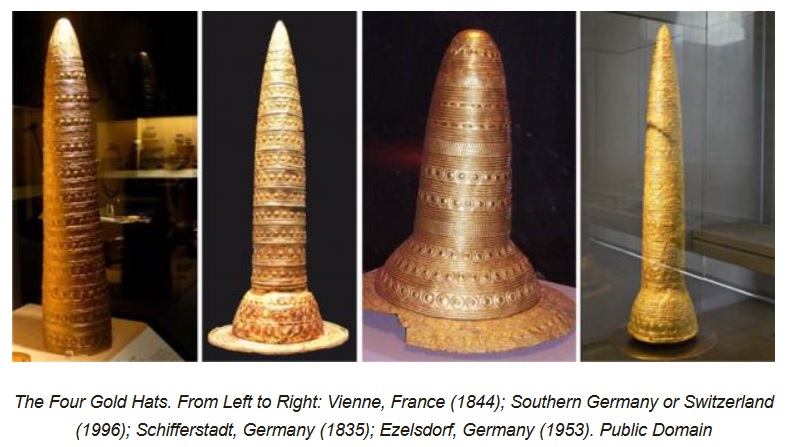"Wilfried Menghin, the director of the Berlin Museum, has been extensively studying the hats. According to Menghin, the king-priests “would have been regarded as Lords of Time who had access to a divine knowledge that enabled them to look into the future." - Ancient Origins article
Ancient people may have believed that the wearers of these hats had powers of prophecy because they were able to accurately predict the changing of the seasons.
The oldest of these hats was buried in 1600 BC (this date missing from above article but I found at the actual hat exhibit yesterday in the Martin-Gropius-Bau Archaeological Museum in Berlin) but had been in use for centuries before its burial. One thing in common is that all four of these hats were buried before the introduction of the Hallstatt Culture in these areas.
I am not an expert on Celtic research. I have tried to learn as much as I can about the Hallstatt Culture, have found many conflicting maps, and am not sure which ones are the most definitive.
Going from the map from Wikipedia depicting a core Hallstatt zone along the German-Austrian border, all four Golden Hats are found outside the core Hallstatt zone but within later confirmed Celtic territory.

Did these hats simply "go out of style"? Or were they no longer produced because the tradition was replaced with one from a competing religion? Perhaps the Hallstatt Celts had been practicing a different tradition that did not use golden hats. Where their influence and culture spread, the hats may have been abandoned due to a willingness of peripheral cultures to conform to the practices of the new elite. But the process may have been forceful if the Time Lords were unwilling to simply fade into the dust.
What culture did the Golden Hat people belong to? Given the oldest hat's burial 1600 BC the cult of the Golden Hats predates the Tumulus Culture.
Maybe the Golden Hat people were speaking a Celtic or non-Celtic Indo-European language. If Celtic languages were being spoken in the British Isles at this time, then it makes sense that this area between the Isles and the core Hallstatt zone would also have been speaking a form of Celtic. It may have been the same language as Hallstatt Celtic (later version known as Gallic) or closely related.
Anyone with additional information and links to research articles is encouraged to post.

Hello Hunter Provyn,
the Golden Hat of Berlin is localised from Bullenheim, middle Franconia, northern bavaria. I know it because I lived there, and there was a big exhibition about the gold treasure. Please translate the text with internet, my english is not good enogh for the archaic items…
Kind Rergards
Cornelia
Archäologisch ist Ippesheim am Fuße des Bullenheimer Bergs äußerst interessant, denn hier wurde im Jahr 1988 eine Kreisgrabenanlage (http://de.m.wikipedia.org/wiki/Kreisgrabenanlage) mit 65 m Durchmesser aus der Luft entdeckt. Sie ist in der Landschaft nicht mehr gekennzeichnet. Man findet den Grabungsort am nördlichen Ortsausgang (auf dem Mühlenweg) nach der kleinen Brücke links abbiegen und an der alten beschrifteten Eiche die kleine Strasse hinauf. Oben auf dem Plateau des Hügels, etwa 200 m im Acker ist die ehemalige Grabungsstelle für die Kreisgrabenanlage. Leider ist kein Hinweisschild vorhanden, aber der Ausblick ist herrlich!
Sie gehörte zur Großgartacher Kultur (ca. 4.900 v. Chr.) und ist demnach etwa 3.000 Jahre älter als die Bullenheimer Höhensiedlung. (Noch älter die Kreisgrabenanlage von Goseck: https://kirkes1.wordpress.com/2014/04/21/4-tage-an-saale-unstrut/ )
Die Erbauer der Kreisgrabenanlage, unsere fernen ferneb Vorfahren, nutzten die markanten Punkte des östlichen Horizonts auf diesem Hügel, um die Beobachtungsgenauigkeit der Sonnenwenden um mindestens den Faktor 10 zu erhöhen. Das spektakuläre Auftauchen der Sonnenscheibe im Zwickel zwischen dem Südhang des Bullenheimer Bergs und der blickdichten Palisadenwand war nur einmal im Jahr zu sehen. Analog erlaubte die Peilung zum Südhang des Weigenheimer Kapellbergs eine taggenaue Bestimmung der Wintersonnenwende.
Rätselhaft bleibt die Bestattung einer jungen Frau (Anfang 30) die in senkrechter Position im Zentrum der Anlage begraben wurde. In der Grube befand sich ein reich verziertes Bauchknickgefäß, das in die Zeit 4.700 v. Chr. einzuordnen ist. Bislang bleibt diese Senkrechtbestattung ohne Vergleich im prähistorischen Mitteleuropa. Die Bestattung mit dem Kopf nach unten und der räumliche Bezug im Zentrum sprechen für ein „Auflassungsopfer“. Warum die Anlage nach wenigen Generationen bereits wieder aufgegeben wurde, ist noch nicht erforscht.
Der Ursprung des Berliner Goldhut, der aus einer Raubgrabung stammt, wird als ursprünglichen Fundort vom Bullenheimer Berg verortet, denn im gleichen Jahr 1996 wurde der Bullenheimer Goldschatz (Ornat) auf dem Schwarzmarkt angeboten und vom Bayerischen Staat gekauft. Beide Funde (der goldene Ornat und der Goldhut) zeigen die gleichen Ornamentmuster, zudem wurden alle Goldhüte auf der Ost-West-Linie 49° gefunden, auch Bullenheim liegt bei 49,6°. ( siehe auch: Bronzezeit und unser Goldhut | Wanderlust: https://kirkes1.wordpress.com/2014/04/07/bronzezeit-und-unser-goldhut/)
Auf dem Bullenheimer Berg lebten damals auf einer Fläche von 38 Hektar etwa 1.500 Menschen. Das war damals eine Großstadt, denn es lebten nur ca. 30 – 40 Mio. Menschen auf der Erde. Das Vorhandensein eines Kultwagens als fahrbare „Vogel-Sonnenbarke“ verstärkt den Eindruck, dass der Bullenheimer Berg ein „heiliger Berg“ war.